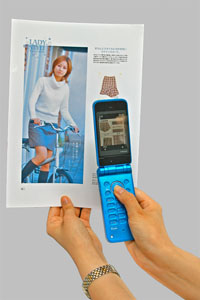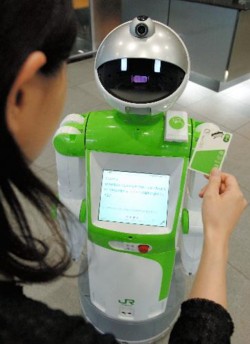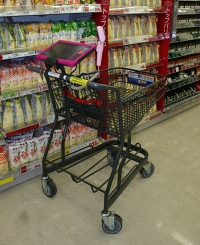Robots old and new are on display at the CEATEC 2008 home electronics trade show currently underway in Chiba, Japan.

Nissan BR23C Biomimetic Robot Car
Nissan unveiled the bumblebee-inspired BR23C Biomimetic Robot Car, which is equipped with a prototype collision avoidance system developed in cooperation with the University of Tokyo. The next-generation safety technology is modeled after the way that bees avoid crashing into each other.
* * * * *

Mechadroid Type C3
The Mechadroid Type C3 receptionist robot developed by Business Design Laboratory relies on face recognition technology, a touch panel display, speech, and facial expressions to interact with visitors and guide them to their destination.
* * * * *

ifbot
Ifbot -- also developed by Business Design Laboratory -- is a speech-capable robot that can identify emotions in the voice and word choice of the person talking. The robot can also communicate its own emotions with a range of facial expressions.
* * * * *

Murata Seiko-chan and Seisaku-kun (a.k.a. Murata Boy)
Murata Manufacturing Co., Ltd.'s popular robot bicyclist, Murata Seisaku-kun (a.k.a. Murata Boy), was joined on stage by his recently-unveiled younger cousin, Murata Seiko-chan, who is well-balanced enough to ride a unicycle.
* * * * *

Nabaztag
The Nabaztag Wi-Fi Smart Rabbit manufactured by Violet is a bunny-shaped personal assistant that connects to your home wireless network.

Nabaztag
In addition to announcing the latest news, weather and traffic information, the rabbit can tell the time, light up when email arrives, stream Internet radio and podcasts, and respond to spoken commands.
* * * * *

Enon leads the way to the wine section
Fujitsu's Enon robot demonstrated the ability to interact with customers and guide them to the wine section.

Enon takes a break

 On September 13, Fujitsu unveiled a new type of "invisible" barcode, called FP (Fine Picture) code, which allows data to be embedded directly into color print photographs. FP code consists of a series of faint yellow lines -- said to be invisible to the naked eye -- which are overlaid on the photograph during the printing process. Once encoded, a photograph can retain its original quality while serving as an "
On September 13, Fujitsu unveiled a new type of "invisible" barcode, called FP (Fine Picture) code, which allows data to be embedded directly into color print photographs. FP code consists of a series of faint yellow lines -- said to be invisible to the naked eye -- which are overlaid on the photograph during the printing process. Once encoded, a photograph can retain its original quality while serving as an " East Japan Railway Company (
East Japan Railway Company ( On January 25, Fujitsu, AEON and Dai Nippon Printing announced plans to conduct a trial run of a retail support system that uses IC tags and data display terminals. In this retail service system of the future, customers will be able access a variety of product information by electronically reading tags placed on supermarket shelves. The trial run will be conducted at Jusco supermarket (Yachiyo-midorigaoka branch) for a five-week period beginning February 6, in Yachiyo City, Chiba.
On January 25, Fujitsu, AEON and Dai Nippon Printing announced plans to conduct a trial run of a retail support system that uses IC tags and data display terminals. In this retail service system of the future, customers will be able access a variety of product information by electronically reading tags placed on supermarket shelves. The trial run will be conducted at Jusco supermarket (Yachiyo-midorigaoka branch) for a five-week period beginning February 6, in Yachiyo City, Chiba.